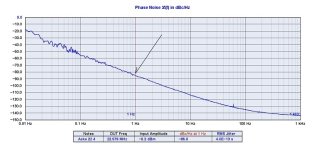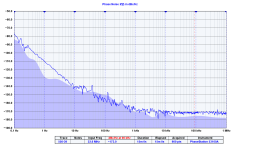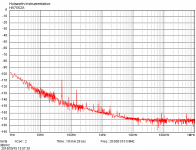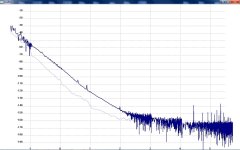Measuring phase noise (both PM and AM) in frequency domain is described here: https://tf.nist.gov/general/tn1337/Tn190.pdfIn the time domain, phase noise is timing error. Amplitude noise is amplitude error. For amplitude to affect time, there has to be mode conversion?
Clock phase noise plots are also made in frequency domain so why do you prefer them?
It can be done either way in theory. What I would not expect to work all that well would be trying to distinguish the two types of noise if phase information is discarded from the FFT.
Also IIRC the old way of measuring phase noise with a $50k rack of equipment already had the ability to demodulate clock phase noise. So some people probably still have the equipment to do that. Don't know what might be involved to try to measure phase noise coming out of a dac if one already had such equipment on hand.
Also IIRC the old way of measuring phase noise with a $50k rack of equipment already had the ability to demodulate clock phase noise. So some people probably still have the equipment to do that. Don't know what might be involved to try to measure phase noise coming out of a dac if one already had such equipment on hand.
Last edited:
It certainly would be interesting to see demodulated clock phase noise measured from dac output. I should also mention that differences in clocks are visible in the measurements I have made. However these differences are quite small which again points to the dominant amplitude modulated noise.
One of the things that humans use for localization is ITD. For stereo it would seem to arise from a very stable, precise, and possibly rather small phase difference of a given audible frequency as measured between the stereo channels. All that while possibly a lot of different frequencies are also present on the channels, both common and differential modes, with some of those frequencies relating to amplitude modulation. If we could show clock phase noise correlates with that general type of measurement, it might be more meaningful than to measure phase noise of one channel.
Last edited:
Until we get a suitable instrument, the realistic way is listening tests in a controlled manner.It certainly would be interesting to see demodulated clock phase noise measured from dac output. I should also mention that differences in clocks are visible in the measurements I have made. However these differences are quite small which again points to the dominant amplitude modulated noise.
As we understand it, there are Amplitude and Phase noises in a typical DAC system. The Amplitude one is dominating from some measurements done so far and phase noise is small and usually gets buried.
Question: if we have a nice working setup and only the Clock is changed, would the Amplitude noise in the system remain the same and any differences in what we hear can be attributed to the phase noise of the Clock or something else related to the Clock only?
Yes, amplitude modulated noise would most likely remain the same. As I said even in my measurement differences in clocks are visible but differences are small and nothing like what you see in clock phase noise plots. IMO this type of phase noise measurement is a simple way to ensure that Vref and clock circuits are working as expected.Question: if we have a nice working setup and only the Clock is changed, would the Amplitude noise in the system remain the same and any differences in what we hear can be attributed to the phase noise of the Clock or something else related to the Clock only?
This is great. Paves the way for some interesting tests. Yes , agree with Vref , power supplies and other DAC related stuff. As I indicated earlier the system must sound good already before doing the clock changes to compare.
Based on some positive feedback on clock upgrades, these are mainly from those who use other type of DACs, like R2R, Discrete etc. I wonder if these types are more sensitive to clock jitter and will also show up in measurements of the DAC output?
Based on some positive feedback on clock upgrades, these are mainly from those who use other type of DACs, like R2R, Discrete etc. I wonder if these types are more sensitive to clock jitter and will also show up in measurements of the DAC output?
There are two ways to read the above quote.Based on some positive feedback on clock upgrades, these are mainly from those who use other type of DACs, like R2R, Discrete etc. I wonder if these types are more sensitive to clock jitter and will also show up in measurements of the DAC output?
1:
...these are mainly from those who...I wonder if these types <of people> are more sensitive to clock jitter...
2:
...these are mainly from...other type of DACs, like R2R, Discrete etc. I wonder if these types <of DACs> are more sensitive to clock jitter...
We haven 't done an experiment to clarify if the issue is mostly dominated by #1, #2, or a more or less equal mix of #1 and #2.
My guess at this point would be that some people are sensitive to DAC sound in some particular way and are driven to find a DAC that satisfies them. If they keep looking and perfecting long and hard enough, eventually they find out clocks are one of the significant factors. But, clocks don't matter so much until everything else is at a certain level. Don't know if people who don't care or notice space as much will hear much difference between good dacs and clocks without some training.
Also IME its very easy to have at least one unknown/hidden fault in a system that masks the effects of better clocks. It doesn't take much 'not-quite-right' to collapse the stereo illusion into something less than its best, or less than close enough to its best, for clocks to have a particularly significant effect on music enjoyment.
I have measured some R2R dacs (e.g. AD1862, PCM1702) using the same method and result have been worse but that may be partly due to lower bit-depth. MarcelvdG's RTZ shift register dac could be interesting to measure as it should have very low noise Vref circuit so amplitude modulated noise may be lower.Based on some positive feedback on clock upgrades, these are mainly from those who use other type of DACs, like R2R, Discrete etc. I wonder if these types are more sensitive to clock jitter and will also show up in measurements of the DAC output?
I have noticed that many people using these so called SOA clocks are also claiming to hear differences in network switches or routers, host OS, ethernet or USB cables etc. So I choose to have a different view on this.My guess at this point would be that some people are sensitive to DAC sound in some particular way and are driven to find a DAC that satisfies them. If they keep looking and perfecting long and hard enough, eventually they find out clocks are one of the significant factors.
Ok, I will do some listening tests later with my upcoming AK4499EX and ES9039PRO based DACs.
Clocks: $1 one like that you did measurement tests, NDK2250 select tested by Jocko and my latest AKX22 OCXO HCMOS version.
The plots show large differences between NDK and AKX22 to start with.
Clocks: $1 one like that you did measurement tests, NDK2250 select tested by Jocko and my latest AKX22 OCXO HCMOS version.
The plots show large differences between NDK and AKX22 to start with.
Attachments
Last edited:
Btw, what sort DAC do you use for your reference listening?I have measured some R2R dacs (e.g. AD1862, PCM1702) using the same method and result have been worse but that may be partly due to lower bit-depth. MarcelvdG's RTZ shift register dac could be interesting to measure as it should have very low noise Vref circuit so amplitude modulated noise may be lower.
Lately I have mostly been using my dual mono AK4493 and ES9038Q2M dacs as well as AD1862 or PCM1702+PMD100. Sometimes my older TDA1541 with tube buffer. So I don't have a dedicated reference dac. Whenever I do listening comparisons I try to use my AB gadget that makes it possible to match levels to within 0.1dB and do random AB switching without any visual cues. But in general I have found dac listening tests quite unsatisfactory as the differences in recordings (e.g. soundstage) are huge compared to possible differences in dacs.Btw, what sort DAC do you use for your reference listening?
Here it was found out recently using the FPGA-based Simple DSD Converter, with various versions of test firmware, that slight changes in the PCM->DSD256 conversion algorithm can have a substantial effect on sound stage. Was quite unexpected. Only point is that its not just the dac itself that affects reproduction of sound stage, it can sometimes be things not predicted to have much if any effect.
Nothing serious, just curious know about the equipment usedHow would you define "reference listening?"
Acko,
I have Andrea's 22,579 MHz Drixo, and confirmed that it sits exactly at the above values, as he had shown in his own phase noise plot as well.
Your plot shows -110dBc/1Hz & -140dBc/10Hz.
So Your 22,579 MHz oscillator is claimed to be 10dB better at 1Hz, 10Hz than either the original producers factory claim or Andrea's clock at the same frequency..
So .. are we shure that it is a correct, repeatable typical result that a random customer would receive ..? 🤔
Very interesting, but I note some discrepancy: the producer displays phase noise results for different frequencies. They do not show 22MHz results but they have measured 20MHz units. Now that 20MHz phase noise plot is just slightly worse than -100dBc/1Hz & -130dBc/10Hz.My latest AKX22 OCXO HCMOS version
I have Andrea's 22,579 MHz Drixo, and confirmed that it sits exactly at the above values, as he had shown in his own phase noise plot as well.
Your plot shows -110dBc/1Hz & -140dBc/10Hz.
So Your 22,579 MHz oscillator is claimed to be 10dB better at 1Hz, 10Hz than either the original producers factory claim or Andrea's clock at the same frequency..
So .. are we shure that it is a correct, repeatable typical result that a random customer would receive ..? 🤔
Attachments
-
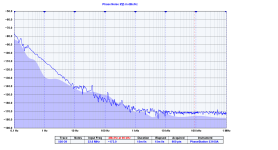 AKX22-22.5792MHz HCMOS.png36 KB · Views: 52
AKX22-22.5792MHz HCMOS.png36 KB · Views: 52 -
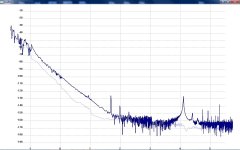 MORI_22579_2xMIT260_VPF148_MHz_15vTPS7A_5VTPS_cardboard_mass_2 (1).jpg167.5 KB · Views: 50
MORI_22579_2xMIT260_VPF148_MHz_15vTPS7A_5VTPS_cardboard_mass_2 (1).jpg167.5 KB · Views: 50 -
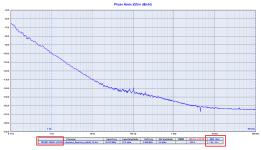 DRIXO 225792 MHz (1).png26.4 KB · Views: 47
DRIXO 225792 MHz (1).png26.4 KB · Views: 47 -
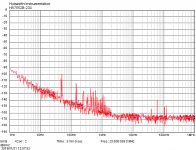 25MHz C 14 18-654_163-33 (1).png30.5 KB · Views: 48
25MHz C 14 18-654_163-33 (1).png30.5 KB · Views: 48 -
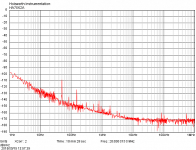 20MHz C 14-586-24 (C13+2.2uF C12+2p R37 180k).png28.9 KB · Views: 44
20MHz C 14-586-24 (C13+2.2uF C12+2p R37 180k).png28.9 KB · Views: 44
Furthermore, I have measured a Wenzel Citrine series 40MHz space qualified OCXO as well. I shows ~-87dBc /1Hz -120dBc/10Hz. That's light years ahead of any NDK, Crystek oscillators at this frequency.
Still, 20dB worse than your plot.. while according to phyics, at double the frequency it should be 6dB worse..
In other words: MagicXtal 20MHz plot gives -97dBc/1Hz; -127dBc /10Hz
My measurement for the Wenzel Citrine 40MHz OCXO is -87dBc/1Hz ; -120dBc/10Hz
The Wenzel shows close to 6dB (7dB) worse value at 10Hz point, at double frequency with respect to the MagicXtal oscillator.. Both of them great oscillators, and the physics is OK with them..
Still, 20dB worse than your plot.. while according to phyics, at double the frequency it should be 6dB worse..
In other words: MagicXtal 20MHz plot gives -97dBc/1Hz; -127dBc /10Hz
My measurement for the Wenzel Citrine 40MHz OCXO is -87dBc/1Hz ; -120dBc/10Hz
The Wenzel shows close to 6dB (7dB) worse value at 10Hz point, at double frequency with respect to the MagicXtal oscillator.. Both of them great oscillators, and the physics is OK with them..
Attachments
I am not sure about other designs but I have got all my samples tested with similar results as measured by a calibrated phase noise analyser… So Your 22,579 MHz oscillator is claimed to be 10dB better at 1Hz, 10Hz than either the original producers factory claim or Andrea's clock at the same frequency.. So .. are we sure that it is a correct, repeatable typical result that a random customer would receive ..? 🤔
I can say that I have Andrea's clocks at 22/24MHz, and also at 11/12MHz with doublers (unmeasured ones though). Both have been tried with Andrea's DSD dac. Now have also have a pair of Acko 22/24MHz clocks. IMHO sound is of Acko clocks is closer to sound of 11/12MHz Andrea clocks with doublers. Also, Andrea indicated to me his own tests showed 5/6MHz with two doublers sounded best. That said, IME clocks are sensitive to power supplies, and clocks tend to improve over time if they run continuously.
Bottom line for me at this point: so far as I can tell if the dac (and the rest of the system) is otherwise good enough then there is some audible benefit to better clocking.
Bottom line for me at this point: so far as I can tell if the dac (and the rest of the system) is otherwise good enough then there is some audible benefit to better clocking.
Last edited:
- Home
- Source & Line
- Digital Line Level
- Asynchronous I2S FIFO project, an ultimate weapon to fight the jitter
